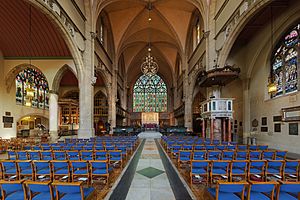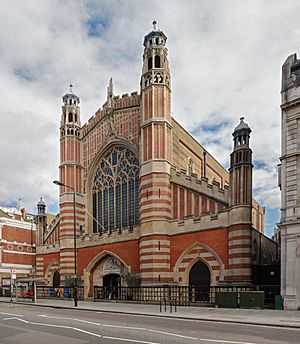Holy Trinity Sloane Street facts for kids
Quick facts for kids Holy Trinity Sloane Street |
|
|---|---|
| The Church of the Holy and Undivided Trinity | |
 |
|
| Location | Sloane Street, London |
| Country | England |
| Denomination | Anglican |
| Churchmanship | Anglo-Catholic |
| Website | www.sloanechurch.org |
| History | |
| Dedicated | 1890 |
| Architecture | |
| Architect(s) | John Dando Sedding |
| Style | Arts and Crafts Gothic |
| Years built | 1888–1890 |
| Administration | |
| Parish | Upper Chelsea, Holy Trinity with St Saviour |
| Deanery | Chelsea |
| Diocese | Diocese of London |
The Church of the Holy and Undivided Trinity with Saint Jude, Upper Chelsea, often called Holy Trinity Sloane Street, is a Church of England parish church in London, England. It was built between 1888 and 1890 on the south-eastern side of Sloane Street. The church was designed in a special Arts and Crafts style by architect John Dando Sedding. The 5th Earl Cadogan paid for its construction. It replaced an older, smaller church that was less than 60 years old when it was taken down.
This church is a Grade I listed building, which means it's a very important historical building.
Contents
History of Holy Trinity Church
The First Church Building
The very first church on this spot was built between 1828 and 1830. It was designed by James Savage in a Gothic style, using brick with stone decorations. The front of the church, facing the street, had an entrance with tall, eight-sided towers topped with spires. In 1838, it could seat 1,450 people, and by 1881, it could hold 1,600.
It was first meant to be a smaller church helping the main parish church of St Luke. But in 1831, it became its own parish, sometimes known as Upper Chelsea. This first church was closed and taken down in 1888. While the new church was being built, a temporary church made of iron, called a tin tabernacle, was set up nearby. It could hold 800 people.
The Current Church Building
The new church, which is the Holy Trinity building we see today, was built very large. It was designed by John Dando Sedding. Even though it wasn't the longest church in London, it was the widest. It was even a little wider than St Paul's Cathedral.
The inside of the church was decorated by famous sculptors and designers of that time. These included F. W. Pomeroy, H. H. Armstead, Onslow Ford, and Hamo Thornycroft. John Sedding passed away in 1891. After his death, Henry Wilson took over to finish the church's interior design. Some parts, like certain stained glass windows and a decorative strip under the high windows, were never completed. Some of the stone carvings inside are also still unfinished. In the 1920s, the inside walls were painted white, making the church feel much brighter.
The church has a wonderful collection of stained glass windows. The huge east window was made by Edward Burne-Jones and William Morris. There are also windows by William Blake Richmond, Powells, and Christopher Whall. The large west window was never finished. Its plain glass was later destroyed during World War II, but most other windows survived or were fixed.
The church was badly damaged by bombs during World War II. However, it was restored to look almost the same by the early 1960s. After this, some church leaders wanted to close and tear down the building to build a smaller one. But a campaign led by John Betjeman and the Victorian Society stopped this from happening. Today, the church has a busy community.
Music at Holy Trinity
Holy Trinity has always been known for its great Anglican church music. A full choir performed from when the church was built until the 1970s. Since 1987, choral music has become very popular again. This was helped by Bishop Michael Marshall and Andrew O’Brien, who was the Director of Music for many years. The Holy Trinity Choir was restarted, and the music tradition was rebuilt. The church also welcomes other choirs to perform.
The Church Organ
John Sedding, who played the organ himself, designed a very large space for the church's organ. This organ was built by J. W. Walker & Sons Ltd and had four keyboards. It was badly damaged during the Second World War. It was repaired in 1947 and partly rebuilt in 1967.
A major rebuild by Harrison & Harrison was finished in August 2012. The goal was to restore and make the organ about 45% larger. They used the original pipes and added new ones that matched. This made it one of the most important organs in London. It has seventy-one different sounds and about 4,200 pipes.
Famous Organists
Many famous organists have played at Holy Trinity. These include Edwin Lemare (1892–95), Sir Walter Alcock (1895–1902), and H L Balfour (1902–42). All of them were leaders in their field. The tradition of great music continues today.
The composer John Ireland was Sir Walter Alcock's assistant. He hoped to become the main organist when Alcock left in 1902, but he was considered too young. Sir Walter Alcock later played the organ for three coronations at Westminster Abbey.
Holy Trinity Today
Holy Trinity works to connect with Christians around the world through a network of friends. From 2004 to 2012, it was the main church for the Awareness Foundation. This group helps people from different religions understand and respect each other. It has branches in other parts of the world, including the Middle East and North America.
As a local church, Holy Trinity offers different types of worship services and community events. It is also a popular place for concerts. The large main area of the church, which doesn't have fixed pews, can be used for many different events. Some of these events celebrate the artistic spirit that was important when the church was first built. An arts and crafts group was started by Michael Marshall. More recently, an annual summer festival, the Chelsea Schubert Festival, has been held there, along with other concerts throughout the year.
On November 1, 2011, the parish of St Saviour, Upper Chelsea, joined with Holy Trinity. The church building in Walton Place became a smaller, helping church for Holy Trinity.
Notable People Connected to the Church
Many well-known people have attended and helped at Holy Trinity Sloane Street. The church attracted people from different parts of British society. For example, the famous politicians Gladstone and Dilke both went to the church. Gladstone used to walk down the street with the organist, Edwin Lemare, before the main Sunday service. Dilke lived very close by, and his funeral was held at Holy Trinity.
The church also became popular with artists and poets, some of whom were connected to Oscar Wilde. The church has always been important to the Cadogan family, who owned the land it was built on. In the 1920s, the church was very popular and had a large team of clergy. This included the priest and hymn writer Percy Dearmer for a time.
On January 16, 1896, the wedding of George William Howard Bowen to Gertrude Chamberlain took place here. Gertrude was the niece of Joseph Chamberlain, a very important government official.
There is a memorial inside the church to Archibald Sturrock (1816–1909). He was the Chief Locomotive Engineer for the Great Northern Railway from 1850 to 1866. After he retired early, he became a judge and lived in Upper Chelsea.
The actor Ernest Thesiger was a member of the church his whole life. He often helped as an usher and sometimes read lessons during services. He was so active at Holy Trinity between the two World Wars that he paid for some of the stone carvings in the church to be finished.



